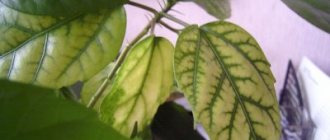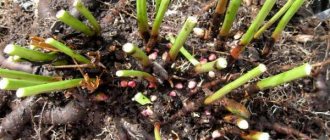Many summer residents who grow these ornamental plants on their plots often wonder: why don’t peonies bloom? Sometimes they do not please with their buds, despite careful care and good weather. To answer the question why peonies don’t bloom, we need to figure out what mistakes we make when growing them. By eliminating the flaws, you can quickly achieve abundant flowering of even relatively young bushes. In its natural environment, peony grows in subtropical and temperate climates. This explains its requirement for high humidity conditions. When wondering why a young bush does not bloom, one should remember that after transplantation the plant is still weak and is not able to produce buds.
General information about how peony develops and blooms
Peony is a perennial shrub. In herbaceous crop species, the above-ground part dies off every year during the winter and resumes the growing season with the arrival of spring, while in tree-like crops it is preserved for the winter. The plant has a powerful root system, deepening up to 1 m. Thanks to this, the shrub is able to provide itself with moisture even during periods of drought, and withstand frosts down to -35 degrees.
Only healthy peony bushes can bloom profusely.
Regeneration buds form in the upper part of the root of peonies. They have a two-year life cycle. The formation of new buds occurs annually at the end of flowering. It is thanks to them that the plant grows new shoots and forms buds every year.
Peonies bloom in the second half of May or June, depending on the type and variety. The plant forms apical buds. Flowering duration is 10-14 days. At the end, fruits are formed in which the seeds ripen. Closer to autumn, the above-ground part of herbaceous plant species begins to fade, and the growth of new shoots begins only next spring.
Important! After planting, the peony seedling should bloom in the third year, and before that it is actively growing its root system.
Botanical description of Bartzell's peony
The Bartzella (or Bartzella) variety was obtained as a result of complex breeding work carried out by the assistant and follower of the Japanese scientist Toichi Ito, who is the founder of a new group of peonies named in his honor. Ito-peonies are intersectional hybrids created with the participation of milk-flowering and tree-like varieties. Bartzella was introduced into cultivation in 1972 and since then its popularity has not waned, despite the fact that at present there are already many other yellow-flowered Ito hybrids.
The Bartzell peony blooms on annual shoots emerging from the base of the bush, like herbaceous varieties. But at the same time, it retains the lower lignified part with renewal buds, which can successfully overwinter under the condition of a combination of additional shelter and a relatively mild snowy winter. The height of the bush is up to 90 cm, in harsh conditions (Siberia, the Urals) - no higher than 50 cm.
The leaves of Ito peonies remain decorative until late autumn, like those of tree varieties, acquiring a copper-red color. The flower of Bartzell's peony is double, large, pale yellow in color with red or dark pink strokes in the core. Flowering time is from mid-June onwards for almost a month. Bartzella has a subtle, pleasant aroma; without this clarification, the description of the variety would be incomplete.
The main mistakes when planting, leading to poor development and how to fix it
Sometimes the reason why a peony does not bloom at all on time may be due to improper planting. This is very important for this culture. Therefore, you should understand the possible options for mistakes made.
Inappropriate location selected
Why don't violets bloom - how to make them bloom?
For the full development of the bush and abundant flowering, you need to choose a suitable place. This culture prefers to grow in open sunny places, protected from drafts. In this case, it is necessary that the duration of daylight hours be at least 6-7 hours, especially during the period of bud formation. When placing a peony in the shade, the shrub actively grows shoots and foliage, but blooms poorly or does not form buds at all.
Important! You can plant peonies under the canopy of trees, but they should not block the light.
Before planting, you should also determine the acidity level of the soil. For peony, the optimal pH is 6.5. Exceeding this indicator is one of the reasons why peony does not grow or bloom. Therefore, experienced gardeners recommend determining acidity in advance. This will allow you to correct the situation in time. To do this, you will need to add lime to the planting hole and carefully move it with the soil. After this, the peony can be planted after six months.
The reason for the lack of flowering may be an increased pH level
Incorrect landing
A peony may stop blooming even if the cuttings are not deepened correctly during planting.
- If the root is located too close to the soil surface, the restoration buds freeze in winter and suffer from lack of moisture in the warm season.
- And deep planting leads to the fact that only a few buds may bloom or there is no flowering at all.
There are also situations when the landing was initially carried out correctly. But when covering a shrub in the fall, its root system is regularly sprinkled with a thick layer of peat or humus. And in the spring it is not completely removed. And after a few years, its root deepens significantly.
Careful weeding can also cause the bush to stop blooming. In this case, its roots are gradually exposed.
Attention! The optimal level for a peony is considered to be when the distance from the topmost bud to the soil surface is 3-5 cm when planting in heavy soil, and 5-7 cm in light soil.
To make a shrub bloom in this case, you just need to dig it up and plant it taking into account the requirements of the crop.
Frequent transplantation
The peculiarity of peonies is that the plant, first of all, after planting, directs all its forces to the development of the root system. This takes 2 years.
Therefore, during this period the bush not only does not bloom, but also weakly grows shoots. Its first flowering occurs only in the 3rd year. Therefore, frequent replanting may be one of the reasons that the bush does not form buds.
Important! Only mature bushes that are at least 5 years old can be replanted.
Planting the hybrid Barthel
When planting Bartzella peony, there are three important points to consider:
- The hybrid grows well in partial shade. The plant needs sunlight no more than 6 hours a day; the rest of the time, the flowerbed should be covered by the shadow of the nearest tree.
- It is advisable to protect the peony from the windy side with a fence or building. Gusty winds impair flowering.
- The site should not be protected from spring floods. Because stagnation of moisture contributes to rotting of the root system. If groundwater comes close to the surface, then the flowerbed must be artificially raised.
Preparation of seedlings
Young plants are vulnerable to many infections, so before planting the seedling should be prepared:
- clean the roots from mold and rot with a knife;
- sprinkle the cut areas with wood ash;
- soak the tubers in a manganese solution (1 g of potassium permanganate per 2 liters of water);
- Before planting, treat the seedling with Rooter or Kornevin.
Important! You need to buy planting material only from a trusted supplier. The seedling should have strong tubers with 2-4 buds.
What soil is suitable?
Bartel prefers light and nutritious soil. In order for the bush to bloom to its full potential, the soil must first be prepared:
- Clear the flowerbed of weeds and dig deep.
- Apply fertilizer: 1.5 cups of double superphosphate and 2-3 cups of ash per 1 m² of area.
- If the soil is heavy (chernozem or clay), then it must be loosened with coarse sand (up to 10 kg/m²).
- To deoxidize the soil, add dolomite and bone meal (1-3 cups per 1 m²).
Information! ITO peonies love slightly acidic soil with a pH level in the range of 5.5-6.5.
When to plant?
It is better to plant Bartzella in one of three periods:
- Planting in late August - early September will allow young seedlings to avoid the summer heat, pest attacks and calmly prepare for wintering.
- You can plant a seedling in early spring, immediately after return frosts. At the same time, it will be susceptible to diseases and will not rise above 30 cm in the first two years.
- Seedlings go on sale in early spring. To plant a young peony in the fall, it will have to be kept in a pot until the end of the spring-summer season.
Errors in care and how to correct them
Diseases of dahlias - what they are, why they grow poorly and do not bloom
A provoking factor as to why garden peonies do not produce buds may also be improper care. In this case, you need to determine the root cause in order to eliminate it.
Bush flooding
This crop cannot tolerate prolonged stagnation of moisture in the soil, so it cannot be grown on clay soil without first adding sand and peat. Overmoistening can be detected by the dark border on the leaves, which indicates the development of root rot in the peony. The groundwater level should also be taken into account. It must be at least 1.5 m.
Excessive or insufficient watering can harm a peony.
Watering too frequently can also cause moisture stagnation. Peonies are among the plants that are able to independently provide themselves with moisture even during dry periods. Therefore, humidification should be carried out only during a long absence of rain. In this case, watering should be 2-3 times a week, soaking the soil by 20 cm.
Flooding of a bush may be due to its placement in an area where melt water stagnates. Therefore, experienced gardeners recommend planting shrubs on a hill.
Excess or lack of fertilizers in the soil
Peony buds may not bloom as a result of improper feeding. Each stage of shrub development requires certain nutrients.
- In spring, during the period of active growth of shoots and foliage, the plant needs nitrogen. Therefore, at this stage it is necessary to use organic matter or mineral fertilizers with a high content (urea, ammonium nitrate).
- And at the moment the buds form and when they begin to open, the peony needs phosphorus and potassium. These components are responsible for the color intensity, flower size and frost resistance.
Important! With excessive application of nitrogen and lack of potassium, the peony actively increases green mass to the detriment of flowering.
To correct the situation, it is necessary to adjust the feeding. This means that you need to stop using nitrogen fertilizers during the period of bud formation, and switch purely to phosphorus-potassium mixtures or wood ash.
Pruning rules not followed
After flowering ends, the life cycle of the shrub continues. During this period, the peony restores the energy spent on the formation of buds, prepares for the upcoming winter and lays new buds for restoration. Therefore, leaves play an important role, as they provide the plant with additional nutrition.
It is impossible to cut off the above-ground part of the peony ahead of time.
If you prune the shoots early, this will significantly weaken the bush, and it may stop blooming the next year. Therefore, experts recommend not removing leaves and stems until they wilt. And even when cutting peonies into a bouquet, you need to leave at least 2-3 plates at the bottom.
Important! It is necessary to cut off the above-ground part of peonies only when autumn frosts occur, and in herbaceous species completely, and in tree-like ones - by 1/3.
Launching the root system
Despite the fact that a peony can grow in one place for 50 years, it needs periodic replanting. This is due to the fact that over time there is a gradual destruction of the main root. As a result, several small bushes are formed around.
If they are not divided in a timely manner and the rotted shoot is not removed, the bush will consist of many weakened shoots that will never bloom.
Secrets of care
Bartzell's peony is unpretentious in care, but in order to increase the number of flowers on the bush and the flowering period, as well as preserve the bushes for a long period, it is necessary to carry out careful care:
- Watering is carried out 1-2 times a week, for a bush 3-15 liters. If the weather is dry, then water 3-4 times a week in the evening. After heavy rain, 3-4 days should pass before new watering. During heavy rainfalls, drainage grooves are made around the bush;
- Fertilizer is applied 3-4 times: after removing the mulch layer - fertilizer for growth; during the formation of buds - complex fertilizer; during flowering and before the first frost;
- Pruning is carried out in the fall, all stems are cut off, leaving 7-8 cm above the ground. During the summer, diseased, damaged stems or faded flowers are removed;
- Weeds are removed as they grow. The ground for peony is often loosened, especially in dry weather, when the soil cracks and after heavy heavy rains, otherwise it will stop blooming and the roots will begin to disappear;
- Preparing for winter. Bartzella is resistant to frost and temperature changes and does not require special shelter. To be sure, especially in the first 2 years, you can hill up higher and cover with a layer of mulch when constant weather sets in -3-5°C. In the spring, with the onset of constant weather from -3 to 0, the mulch is removed so that the buds begin to grow;
- Prevention of diseases and pests. The hybrid is resistant to diseases, but like most plants it can become infected from neighboring flowers or by pests. Most often, ants, aphids and spider mites are found on flowers and leaves, which are eliminated with the help of special insecticides. Diseases that can occur on Bartzell are powdery mildew, gray rot, rust, spotting. They are eliminated using fungicides and damaged shoots and stems are removed. When a plant is overcome by worms or root rot, it must be dug up, cut off the damaged roots, treated with manganese and planted in another place.
Such care for a peony, especially a new seedling, will increase the number of flowers and the root system will grow better.
This is interesting: Tree peony
Features of the plant
The lack of flowering in peonies may also be due to the age of the bush. Therefore, in some cases this may be one of the reasons.
Too young bush
White peonies - description and characteristics of the best varieties with a colored center
If you plant a tree that is too small, you will have to wait a long time for the first flowering. The peculiarity of peony is that with an insufficiently developed root system, the shrub does not grow shoots and buds.
In this case, you need to be patient and provide the plant with proper care. In gratitude for this, the grown peony will delight you with its lush flowering.
Too old
With age, the shrub has the ability to become obsolete. In this case, the peony flowers are significantly reduced in size, their number is reduced or they are completely absent. All these signs indicate the need to divide the bush.
To do this, you need to dig up the plant at the end of August, shake off the soil from the roots and wash it thoroughly. Then put it in a shaded place for 2 hours, which will allow you to divide the root without much difficulty.
At the end of the time, using a sharp knife, you need to cut the bush into several parts. Each of them should have 3-5 recovery buds and the same number of well-developed root shoots. After this, the divisions need to be planted in a permanent place.
Attention! All types of division and pruning must be performed with a sharp, disinfected instrument.
Why do peonies bloom poorly?
The deterioration of the decorative qualities of young bushes is often associated with ignoring such a procedure as cutting off the buds at an early stage. This operation allows the plant’s root system to fully develop. Thanks to this, in 1-2 years the crop will begin to bloom luxuriantly and profusely.
Read more Why and what to do if the buds, leaves, and peony roots have dried out
Lack of flowering can be observed in both young and old bushes
Perennials also need to be rejuvenated. Experienced gardeners carry out division once every 8-10 years, digging up the rhizome and breaking it into several parts, each of which has at least three buds.
External factors
Sometimes the buds on a peony remain unopened as a result of weather conditions. In such a situation, the gardener is unlikely to be able to do anything to correct the problem. Therefore, it is necessary to select zoned varieties that will be less susceptible to unfavorable factors.
Rainy weather during budding
Prolonged rains can cause the petals in the buds to begin to rot. Therefore, the plant will never be able to dissolve them. But this will not affect flowering in the next season. Therefore, we just have to be patient and hope that next time the rain won’t interfere.
High humidity causes buds to rot
The weather is too dry
Lack of moisture in the soil can also provoke premature wilting of buds. In this case, you need to increase watering of the bush. To do this, use settled water at a temperature of +20 degrees. Watering is carried out every other day, wetting the soil to 20 cm.
Also at this time, sprinkling should be applied in the evening to replenish evaporated moisture in the leaves. And to prevent overheating of the roots, you should mulch the soil under the bush with peat or humus.
History of the variety
The year of birth of this variety is 1948, when breeder Ito obtained it by crossing two other varieties:
- paternal plant – variety Kinko (tree-like);
- maternal - Kakoden (milky white).
The result was the appearance of six bushes with yellow buds, which is what the scientist wanted. But it was not Ito himself who finished work on the new variety, but his student and assistant, Anderson, who collaborated with Ito’s widow. Only in 1974 did Bartzell's peonies attract the attention of gardeners and become popular. 2002 was another important date when the variety received the Grand Prix at an international exhibition.
Diseases and pests
The reason for the lack of flowering may be damage to the bushes by fungal diseases and pests.
Possible problems:
- Ants. These insects attack bushes during the formation of buds, which leads to their deformation. To deter them, it is recommended to spray peonies with garlic solution.
- Slugs. This pest causes damage to shrubs during prolonged rainy weather. Slugs feed on buds and young leaves. As a preventive measure, it is necessary to sprinkle the soil at the base of peonies with tobacco dust or wood ash.
- Root rot. The disease develops with prolonged stagnation of moisture. In this case, the leaves and buds of the bush lose their elasticity. This occurs as a result of metabolic disorders in tissues. To save it, you need to dig up the plant, remove the affected areas and replant it in a new place.
- Powdery mildew. The disease develops at high humidity and temperature. It appears as a white coating on the leaves and buds. For treatment, it is necessary to spray the bush with Skor or Topaz.
Pests can also cause lack of flowering
Knowing why peonies do not bloom, you can determine what to do in each specific case. Therefore, if such a problem arises, you need to familiarize yourself with common mistakes made during planting and further care. Since they are most often the main reasons.
Selecting a location
The herbaceous and tree-like peony loves the sun. If you plant it in the shade of a fence or under trees, it is unlikely to ever bloom. Try to arrange it where there are no drafts. Add peat and humus to heavy soil. It is advisable to ensure good drainage.
Bad places to land:
- Blind fence area;
- Shaded front garden;
- Tree trunk area.
In arid regions, peonies do not do well near well-lit house walls, concrete, brick and metal fences, as they overheat during the heat.
In areas with stagnant water and nearby groundwater, it is better to build high beds for peonies. This plant does not tolerate excessive moisture at all.
Move peonies to another location if you notice that:
- In the spring, drops from the roofs fall on them.
- When it rains, water accumulates in the holes, as they are located in the lowlands.
- Water from gutters is directed towards them.
- Moss began to grow on the soil.
Excessive moisture causes the roots to rot and the plant dies. Before it’s too late, dig up the plant, remove the rotted part of the root, and plant healthy cuttings in a more favorable place.
Reason 4. Peony does not have enough moisture
We have already written that peony does not tolerate stagnation of water at the roots, but it loves to “drink.” Watering should be especially abundant in the spring during budding and at the end of the season, when renewal buds are formed, as well as in dry, hot weather.
Remember that there are practically no suction roots at the base of the peony - they are all located further from the center of the bush, on the periphery! Therefore, watering should be carried out in a circular zone at a distance of 20-40 cm from the center (this distance is greater, the older and larger the bush).
Experienced flower growers advise digging a circular groove around the bush about 10 cm deep and watering along it.
When watering, one plant consumes 3-4 buckets of water. As with other crops, watering peonies is best done during periods without active sun - in the morning or evening.
But you should not spray peonies during budding and flowering. This will spoil the appearance of the flowers and may even contribute to the plant becoming infected with gray rot.
Buds dry out - what to do: what to treat and feed
Peonies are planted in August-September. When planted in spring, the bush will not bloom, and even if flower stalks appear, there is a high probability that they will dry out. Thus, one of the reasons is incorrect planting dates.
The main reasons that buds dry out:
- The plant is old and requires replanting;
- Planted too shallow or deep;
- Gray mold disease;
- Soil compaction (siltation);
- Lack of fertilizing.
When affected by gray rot, dark spots and dots appear on the stems. Diseased shoots need to be cut out and destroyed. For gray rot on peonies the following are used:
- Colloidal sulfur;
- Bordeaux mixture;
- Fundazol;
- Copper oxychloride;
- Pure flower.
If the disease is severely affected, not only the plants, but also the soil are treated. This is done in the spring after the cover is removed. The top layer of soil is removed and fresh soil with the addition of sand is poured in its place. The same preparations are used for soil treatment.
Pruning depending on the type: for tree and herbaceous peonies
The tree peony does not like its flowers to be used for bouquets. The next year, flowering is not so abundant or is absent altogether.
For the herbaceous variety of the plant there are no restrictions in this regard, since in the winter the ground part dies off anyway, and flower stalks form on the shoots of the current year.
One of the reasons why tree peony does not bloom is cutting flowers for bouquets. The peduncles of this plant variety are formed on the shoots of last year; if you cut them, there will be no flowers to wait for.
Do not rush to trim the leaves of the herbaceous peony. Don't do this right after flowering has finished, even if they are shielding other crops from the sun. It is better to plan the plantings so that they do not interfere with each other.
The herbaceous garden peony is pruned in October, while the roots are protected from freezing.
Common peony pests and methods of controlling them
Insects are attracted to peony as a place to feed and lay larvae. They violate the integrity of the bush, reduce its immunity and contribute to the penetration of other diseases.
The main pests include:
May beetles or bronze beetles
The larvae lay in the soil. They affect the root system and weaken the plant. The bush withers or may die if 2-4 individuals settle in the roots.
Bronze beetles on a flower
The larvae live in the soil for 3-4 years. Adults eat the leafy part of the plant, but do not cause as much damage as their offspring.
To get rid of the larvae, it is worth digging up the soil and treating it with antichrusch, wallar, zemlin, etc.
These parasites are small in size and live in colonies. Noticeable upon close examination. Their metabolic products create an airtight film on the leaves and buds. The leaf blades wither and curl into a tube, and the buds do not bloom. If the flower has bloomed, you can observe some curliness when viewed from above.
Aphids feed on plant sap and are carriers of many diseases.
Plants that repel insects should be planted around the peony: marigolds, onions, garlic. The leaves are removed and the plant is sprayed with actara, decis, fufanon or a solution with laundry soap.
Root-knot nematodes
Small worms that parasitize the root system. They form growths. They interfere with the normal absorption of water and nutrient juices from the soil. They multiply quickly, creating entire colonies.
For prevention purposes in the spring, before planting, the soil is treated with boiling water up to 80 °C.
To get rid of pests, poisonous gases (nemagon, carbation, etc.) or drugs lindane, karbofos, phosphamide are introduced into the soil.
Hop spinner
Caterpillars that eat the roots of a plant. It is worth digging up the ground and treating it with spark.
Thrips
Small insects that settle on leaves and flowers. They feed on plant juices. The drugs spintor, ortin, fufanon, etc. are effective against them.
Ants
They appear due to aphids, which are looked after to extract their nutritional secretions. You need to get rid of them so that aphids do not multiply. The drugs diazinon, chlorpyrifos, anti-ant, etc. are used.
Important! You should carefully read the description of the preparations so as not to add more chemicals and harm the flower.
Growing Bartzella flower
The flower does not cause any trouble for gardeners. The main thing is to properly prepare for landing.
Selection of seedlings
Peony Julia Rose (Paeonia Itoh Julia Rose)
Planting material (rhizome cuttings) is purchased in agricultural stores. Tubers are sold in peat pots or as seedlings in containers.
The rhizomes are taken elastic, without rot, with 3-5 growing points. There should be no damage or breaks on the tuber. Peony hybrid Bartzell seedlings are purchased immediately before planting.
The crop is not propagated by seeds. The method is needed only by breeders. At home this is not rational.
Boarding time
Peony Ito hybrid Bartzell is planted in the fall. September is the optimal time throughout Russia. There is still a month before frost, the plant will have time to take root and overwinter safely.
You should know! Spring is also possible, but only when the threat of return frosts has passed and the soil has warmed up sufficiently.
Selecting a site, preparing the soil
The plant exuberantly displays its decorative qualities in elevated sunny areas. Tubers are sensitive to excess moisture and rot. Therefore, the peony Itoh Bartzella is not planted in lowlands and places where groundwater is close.
They do not plant it near buildings, so that water from the roofs does not spoil the tubers. Near solid metal fences or brick walls is also not a suitable place - the plant will suffer from the heated material. Fruit trees are bad company for peonies.
The crop prefers fertile, loose soil. If there is high acidity in the area, then the matter is corrected by liming. Sand is added to clay soils. Before planting, the plot is dug up, weeds and stones are removed.
Reproduction by division of rhizomes
Planting step by step
When the tubers and the area are prepared, planting begins. The process looks like this:
- Dig a hole measuring 50x50 cm.
- Expanded clay is poured onto the bottom to remove excess moisture.
- Next comes a layer of sand.
- Fertile soil is poured onto it in a heap. It consists of peat and garden soil. Add ash, superphosphate, and dolomite flour.
- Inspect the rhizomes. If there is rot, cut off with a disinfected knife. The material is kept in manganese (2 g per 5 liters of water).
- A seedling is placed in the center of a mound of soil and the roots are straightened.
- Sprinkle with earth.
At the end of the action, the hole is watered and mulched with peat.
Symptoms indicating that the plant has been attacked by pests
In addition to fungal and viral diseases, peony is susceptible to pests. Harmful insects can infect all parts of the plant: leaves, buds and root system.
Ants on peony are common
The main symptoms by which the presence of pests is determined:
- small holes appear in the root soil. They are broken through by beetle larvae in order to rise closer to the surface in warm weather;
- the appearance of a large number of ants indicates the settlement of aphids;
- Traces of eating appear on the leaves in the form of unevenness along the edges or thinning of the plate in some places.
Note! Pest control will be more effective if you attract natural enemies of insects into the garden: hedgehogs, ground beetles, dragonflies, birds. They are lured by birdhouses installed on the site and bright and fragrant flowers.
Prevention of peony diseases
In order for the plant to resist diseases, organic fertilizers containing nitrogen, potassium and phosphorus are added to the soil. Especially in May, when active growth occurs.
Other preventive measures are also used:
- fallen branches and foliage are removed from the ground in the root area;
- periodically loosen the soil;
- dried parts of the bush are immediately cut off;
- Plants that repel insects are planted next to the peony: onions, garlic, marigolds, etc.;
- Even a healthy plant is treated with soil and bushes twice a season. Use 1% Bordeaux mixture, copper sulfate and phytosporin.
Additional Information . It is better to select unpretentious peony varieties with strong immunity.
Plant in autumn
| Peony Bartzella | |
| general characteristics | Tall bush with spreading stems |
| Plant height | 70-80 cm |
| Flower size | up to 25 cm |
| Color | Yellow |
| Bloom | June July |
| Winter hardiness | Frost-resistant |
Description of the Bartzell peony - photos, planting and care:
- Itoh Bartzella peony (lat. Paeonia Itoh Bartzella) is bright yellow in color with whitish edges on the petals. The hybrid was bred by crossing a tree peony and a herbaceous peony. The bush is spreading, dense, 70-80 cm in height. The stems are strong and practically do not bend under the weight of the inflorescences. The leaf is dark green and open-worked; by autumn it acquires a bronze tint.
- Peony blooms in May-June and forms lush caps of bright inflorescences . The flowers are double with yellow petals, with red strokes at the base. The aroma is delicate and persists even when cut. Flower diameter is up to 25 cm, flowering period is 2-3 weeks.
- They take root well in any soil, are unpretentious in care, and are especially responsive to flowering in fertile soil. They reproduce by dividing the bush. The root system is well developed, the tuberous roots are powerful. Varietal qualities appear 2-3 years after planting. Every year the number of inflorescences increases.
- The variety is used in landscape design and folk medicine. It tolerates frosts well down to -30 without additional shelter, or rather high hilling of the bush. Resistant to diseases and pests and tolerates drought well.
Video: Peony Bartzella











